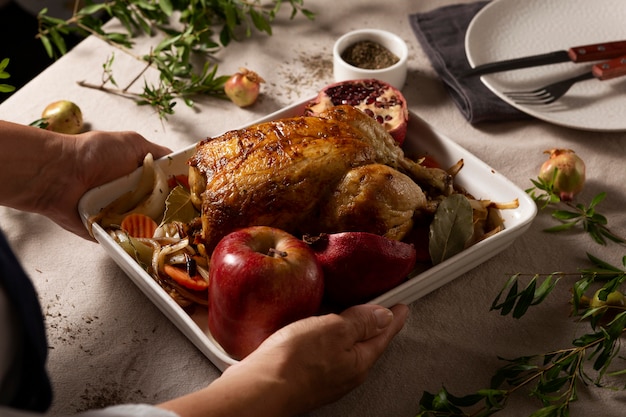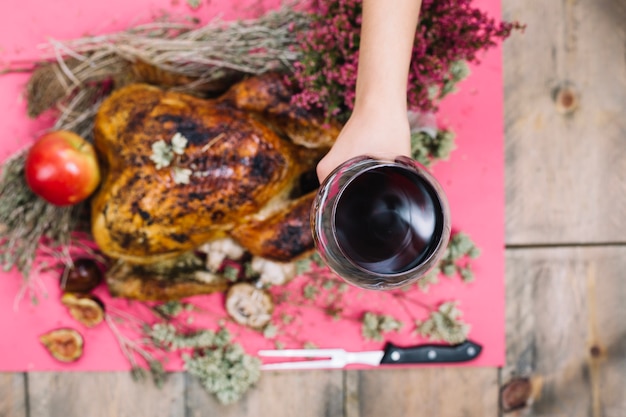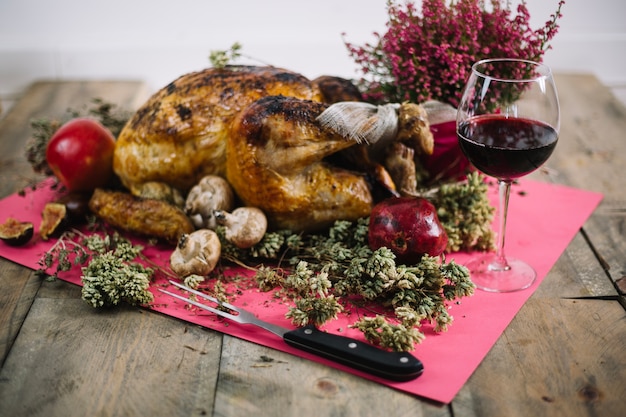Let’s get down to brass tacks, folks. You’re here because you want to cook a turkey roast that’ll have everyone saying, "Wow, this is the best turkey I've ever had!" I’ve been tackling turkeys for years, and I’ve learned a thing or two about making them the star of the show.
So, put on your apron, grab a cuppa, and let's dive into this turkey adventure together.
(Part 1) Choosing the perfect turkey

Alright, let's start at the beginning: choosing the right turkey. It's the foundation for a delicious roast, you know?
The Size Matters
You've got to think about your guest list. If you're expecting a crowd, you'll need a bigger bird. A general rule of thumb is to allow about 1.5 pounds of turkey per person. So, if you're cooking for 10 people, you'll want a turkey weighing around 15 pounds. Don't worry, if you get a slightly smaller or larger turkey, you can adjust the cooking time accordingly.
Fresh or Frozen?
Now, the age-old dilemma: fresh or frozen? Personally, I’ve always preferred fresh turkeys. They tend to have a more robust flavour, and they’re usually plump and juicy. But, if you're short on time or can't find a fresh turkey, frozen is a perfectly acceptable option. Just make sure to thaw it completely in the refrigerator before cooking. This can take a few days, so be sure to plan ahead!
The Look and Feel
Once you’ve got your turkey, give it a good once over. You want a bird with smooth skin, no discoloration, and a good, even colour. The breast should be plump and firm, not sunken or loose. And give it a little squeeze – it should feel springy and not overly squishy. This tells you the meat is fresh and well-hydrated.
(Part 2) Prepping the Turkey

Alright, you’ve chosen your perfect bird. Now, let’s get it prepped for the roasting stage.
Patting it Dry
First things first, give that turkey a thorough pat down with paper towels, inside and out. This helps the skin get nice and crispy. You don't want any leftover moisture interfering with the browning process, trust me.
Stuffing It Up (Optional)
Now, let's talk about stuffing. Stuffing can add a delightful flavour to your turkey, but it’s important to remember food safety guidelines.
The Danger Zone
The stuffing inside the turkey needs to reach a safe internal temperature, and that can be tricky. The safest option is to cook your stuffing separately in a baking dish. This ensures it cooks evenly and reaches a safe temperature.
The Alternative
If you’re determined to stuff the bird, make sure to stuff it right before roasting and cook the turkey to the recommended temperature (more on that later!). And, remember, stuffing should be cooked until it reaches an internal temperature of 165°F.
Seasoning the Bird
Now, for the fun part – seasoning! This is where you get to unleash your creativity. My go-to seasoning is a simple mix of salt, pepper, garlic powder, and paprika. I rub it all over the turkey, both inside and out.
Other Options
Don't be afraid to experiment! You can add herbs like rosemary, thyme, or sage. You can also use a dry rub, a marinade, or even a glaze. Just make sure to season generously. The flavour will be more intense if you do.
(Part 3) Mastering the Roasting Process

Alright, you’re ready to roast! Let’s make sure we nail this crucial stage.
Choosing Your roasting pan
First, you’ll need a large enough roasting pan. Make sure it has a rack to elevate the turkey above the drippings. This will help the turkey cook evenly and prevent it from sitting in its own juices.
Preheating the Oven
Set your oven to 325°F. Preheating is absolutely essential! It ensures the turkey cooks at the right temperature from the start.
The Placement
Place the turkey in the roasting pan, breast side up. You can add some vegetables like carrots, onions, or potatoes around the turkey, which will add extra flavour to the gravy later.
Basting is Key
Now, here’s where a little TLC comes in. Basting the turkey during roasting is important for a juicy and flavourful bird. You can use melted butter, broth, or a combination of both.
The Timing
Baste the turkey every 30 minutes or so, basting the breast more frequently than the legs. This helps keep the turkey moist and prevents the skin from drying out.
(Part 4) Temperature and Timing
This is where we talk about the numbers. Accurate temperature and timing are key to a perfectly cooked turkey.
Using a meat thermometer
The best way to know if your turkey is cooked through is to use a meat thermometer. Insert it into the thickest part of the thigh, being careful not to touch the bone.
safe internal temperature
The turkey is cooked through when the internal temperature reaches 165°F in the thigh. If you’re stuffing the turkey, it needs to reach 165°F as well.
The roasting time
Now, for the timing. The roasting time will depend on the size of your turkey. A general rule of thumb is to allow 15 minutes per pound for an unstuffed turkey and 20 minutes per pound for a stuffed turkey.
Example
For example, a 12-pound unstuffed turkey will take approximately 3 hours to cook. But remember, these are just estimations. Use your meat thermometer to determine the true doneness.
(Part 5) Resting Time
Okay, your turkey is done. Now, let’s give it a bit of a rest.
Why Rest?
This is a critical step that many people skip. After roasting, the turkey needs time to rest for at least 30 minutes before carving. This allows the juices to redistribute throughout the meat, ensuring a tender and moist turkey.
Cover It Up
Cover the turkey with a loose tent of aluminium foil and let it rest in a warm place. This will help it stay warm and moist.
(Part 6) Carving Time!
Now for the moment of truth – carving your turkey.
The Equipment
You’ll need a sharp carving knife and a carving fork to get the job done. If you’re feeling fancy, you can even use a carving set.
The Technique
Start by carving the breast, slicing it across the grain. Then, carve the legs and thighs, cutting through the joints. Finally, carve the wings.
Pro Tip
If you’re serving the turkey whole, you can carve it at the table. But, if you want to keep it warm, you can carve it in the kitchen and then transfer the slices to a serving platter.
(Part 7) Leftover Magic
Don’t throw away those delicious leftovers!
Turkey Sandwich Bliss
Let’s be honest, a turkey sandwich is the best use of leftovers. Use the turkey slices, cranberry sauce, stuffing, and a bit of gravy for a truly satisfying meal.
Soup, Soup, Wonderful Soup
Leftover turkey also makes a fantastic soup. You can make a creamy turkey noodle soup, a hearty turkey and vegetable soup, or a spicy turkey chili.
Other Options
You can also use leftover turkey in salads, casseroles, or even pasta dishes. Get creative!
(Part 8) Gravy Goodness
No turkey feast is complete without a delicious gravy.
Making the Gravy
Here’s how to make the perfect gravy:
- Strain the pan drippings through a fine-mesh sieve into a saucepan.
- Skim off the fat from the drippings. You can use this for another purpose, like frying potatoes or adding to a soup.
- Whisk in some flour to thicken the gravy. Start with a tablespoon or two and add more as needed.
- Slowly whisk in broth or water until the gravy reaches your desired consistency. You can use chicken, turkey, or even vegetable broth. Don't be afraid to taste it and adjust the seasoning as you go.
- Season to taste with salt, pepper, and other spices. A dash of dried thyme or rosemary can really enhance the flavour.
Other Gravy Options
You can also make a cranberry gravy or a mushroom gravy. The possibilities are endless!
(Part 9) side dishes Delight
Let’s talk about the side dishes.
Traditional Favorites
Some traditional side dishes that pair perfectly with turkey include:
- mashed potatoes. You can't go wrong with a classic like mashed potatoes! They provide a comforting and satisfying contrast to the turkey.
- Stuffing. A classic that adds a touch of breadiness and flavour to the meal.
- Cranberry sauce. Tart and sweet, cranberry sauce adds a delightful contrast to the richness of the turkey.
- green bean casserole. This classic side dish is a staple at many holiday dinners and brings a creamy and comforting touch to the meal.
- sweet potato casserole. Sweet and spiced, this side dish offers a touch of sweetness and decadence to your spread.
Alternative Side Dishes
But, if you’re looking for something a bit different, here are a few alternatives:
- roasted brussels sprouts with bacon. The smoky bacon and slightly bitter Brussels sprouts provide a delicious and satisfying contrast to the turkey. Try roasting them with a bit of maple syrup for a touch of sweetness.
- Honey-glazed carrots. Sweet and savory, honey-glazed carrots are a beautiful and delicious addition to your turkey dinner.
- Sautéed spinach with garlic. Simple yet flavorful, sautéed spinach adds a healthy dose of greens and complements the turkey beautifully.
- Wild rice pilaf. A nutty and hearty side dish that pairs perfectly with turkey and adds a touch of elegance to your spread.
(Part 10) FAQs
Now, let’s answer some common questions.
1. Can I freeze a turkey after it’s thawed?
No, it’s not recommended to freeze a turkey that has already been thawed. Once thawed, it should be cooked as soon as possible. Freezing a thawed turkey can lead to bacteria growth and compromise food safety.
2. How long should I roast a turkey?
The roasting time depends on the size of the turkey. Use the rule of thumb of 15 minutes per pound for an unstuffed turkey and 20 minutes per pound for a stuffed turkey. Always check the internal temperature with a meat thermometer to ensure it’s cooked through.
3. How do I know if a turkey is cooked through?
The best way to know is to use a meat thermometer. The internal temperature should reach 165°F in the thickest part of the thigh. Don't rely solely on visual cues, as they can be deceiving.
4. What should I do if my turkey is overcooked?
It's difficult to fix overcooked turkey, so it's best to prevent it from happening in the first place! Keep an eye on the cooking time, and use a meat thermometer to ensure it’s cooked through.
5. What’s the best way to store leftover turkey?
Store leftover turkey in the refrigerator in an airtight container for up to 3-4 days. You can also freeze leftover turkey for up to 2-3 months. When freezing, wrap the turkey tightly in freezer-safe plastic wrap or foil to prevent freezer burn. To reheat, thaw in the refrigerator overnight and then reheat in the oven or microwave.
And there you have it! My ultimate guide to cooking a delicious turkey roast. Remember, it’s all about practice and patience. Don’t be afraid to experiment and try new things. Most importantly, enjoy the process! You’ll be surprised at how easy it is to create a delicious and impressive turkey roast that your guests will rave about. So, get out there, grab a turkey, and let’s cook!
Everyone is watching

Prime Rib Roast Cooking Time Chart: Per Pound Guide
Cooking TipsPrime rib roast. Just the name conjures images of lavish dinners, crackling fires, and hearty laughter. It’s ...

How Long to Bake Potatoes in the Oven (Perfect Every Time)
Cooking TipsBaked potatoes are a staple in my kitchen. They're incredibly versatile, delicious, and surprisingly easy to m...

Perfect Rice Every Time: The Ultimate Guide to Cooking Rice
Cooking TipsAs a self-proclaimed foodie, I've always been a bit obsessed with rice. It's the foundation of countless cuisi...

The Ultimate Guide to Cooking Asparagus: Tips, Techniques, and Recipes
Cooking TipsAsparagus. The mere mention of this spring delicacy conjures up images of vibrant green spears, crisp and burs...

Ultimate Guide to Cooking the Perfect Thanksgiving Turkey
Cooking TipsThanksgiving. Just the word conjures up images of overflowing tables laden with delicious food, the scent of r...
